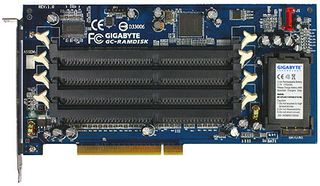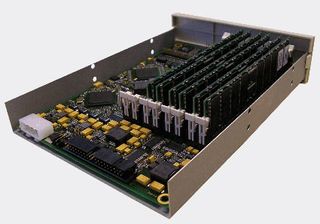HyperDrive 4 Redefines Solid State Storage
Hard Drives, Flash Drives, RAM Drives
The conventional hard drive has two significant advantages: it is relatively cheap, and it is available at capacities ranging from around 80 GB up to one terabyte. There is no affordable alternative to a hard disk drive when it comes to storing hundreds of gigabytes, because the cost of memory for DRAM or Flash drives is still far too high. On the other hand, a hard drive is mechanically sensitive, it is heavier, it creates noise, dissipates some heat and its capabilities of accessing data randomly are limited. The reason can be found in the read/write heads, which have to be moved using mechanical arms to access the required sectors on the rotating discs. There is nothing wrong with hard drives for long-term permanent storage, but enthusiasts and workstation users appreciate better performance of their system storage subsystem, which is where Flash and RAM drives enter the stage.
Hard drives made of Flash memory make a lot of sense, as Flash memory densities have reached levels where it is affordable to create drives with up to 32 GB. We're still talking about several hundred dollars, which will get you a 32 GB drive or a one terabyte conventional hard drive, but the performance benefits are noticeable. Flash memory has low read latency and can be considered robust today despite its limited number of write cycles. Wear leveling algorithms on modern Flash SDDs (solid state drives) make sure that all cells are used evenly. However, Flash drives are even less suitable than hard drives if frequent random write access is required. This is not really an issue in the desktop, as only the user and certain software services ask for random writes. Server environments, however, depend on their storage solutions to deliver a sufficiently high number of I/O operations per second, which can be demanded by databases or by multiple users accessing a storage solution. In such a case, Flash SSDs are even slower than fast conventional hard drives.
RAM-based SSDs are susceptible to power outages, and they are even more expensive. The ideal SDRAM-based SSD has to support an acceptable storage capacity to be suitable as the system drive (8 GB or more today), and requires both a short-term power backup as well as a long-term permanent additional storage solution to backup memory content in the event of a power outage. At capacities of 16 GB and more, you're looking at a four-digit cost for such a solution, but the advantages are incontrovertible: SDRAM offers minimal read and write latencies and high throughput of hundreds of megabytes per second. In theory, SDRAM SSDs are even more reliable, as they're mechanically tolerant against shock and vibration. And finally, you can forget everything you know about defragmentation.
Competitors: Gigabyte i-RAM, HyperDrive III

Gigabyte's i-RAM is quick, but it maxes out at 4 GB due to the limited availability of 2 GB DDR1 DIMMs. The battery is a weak point as well, because a replacement is sometimes hard to get.
The two popular RAM drives until now have been the i-RAM by Gigabyte and the predecessor of the HyperDrive 4, which we're looking at in this review. The HyperDrive III installs into a 5.25" drive bay and offers up to 12 GB capacity using six DDR DIMMs. Unlike Gigabyte's i-RAM, the HyperDrive III requires ECC memory, which allows for the correction of single bit errors on the fly. From this standpoint, the HyperDrive III is the more robust solution when compared to the i-RAM, which only has four instead of eight memory sockets, and installs into a 5 V PCI slot.
Both solutions have a battery backup unit to protect the memory contents from a power outage. However, the i-RAM's battery will not last longer than 16 hours, according to Gigabyte, and the backup unit for the HyperDrive III will only buffer data for a few hours. HyperOS includes a power supply, but of course that doesn't help if the power grid is gone. In both cases, you don't have an option to purchase a UPS unit if you want to be on the safe side. Even if you did use one, the data on your solid state drive will be dead in the water if the UPS runs out of power. The only reliable long run solution is an additional permanent storage backup for the solid state drive.

The HyperDrive III fits in a 5.25" drive bay and supports up to 12 GB of DDR1 memory, but is limited to UltraATA/100. It's also several times more expensive than an i-RAM.
Stay on the Cutting Edge
Join the experts who read Tom's Hardware for the inside track on enthusiast PC tech news — and have for over 25 years. We'll send breaking news and in-depth reviews of CPUs, GPUs, AI, maker hardware and more straight to your inbox.
Current page: Hard Drives, Flash Drives, RAM Drives
Prev Page HyperDrive 4 - The Fastest Hard Disk In The World? Next Page The HyperDrive 4 By HyperOS / Accelerated Logic